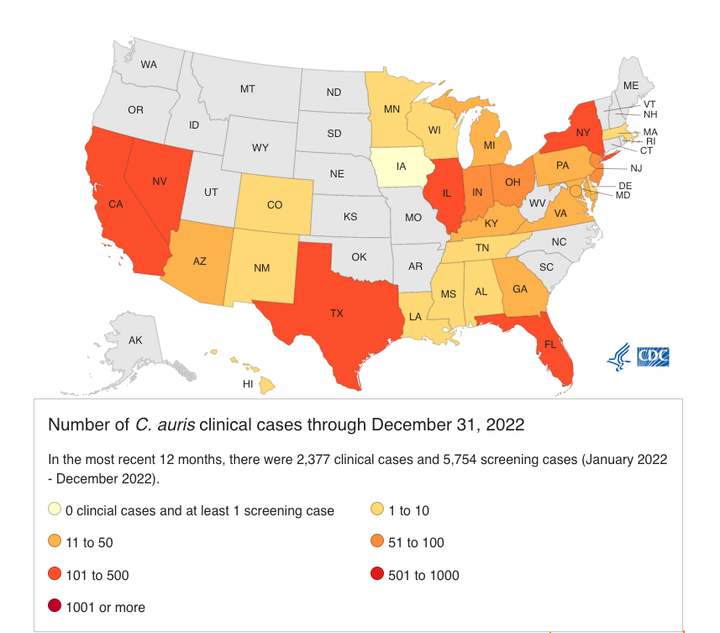Candida auris is a type of yeast that can cause severe infection in people who have weak immune systems or use medical devices, according to a new study.
A deadly fungus that is resistant to most drugs is spreading at “an alarming rate” in health care facilities across the county, the Centers for Disease Control and Prevention said this week.
Candida auris, or C. auris, is an emerging fungus that is considered an urgent antimicrobial resistance threat. It can linger on the skin and throughout the body, as well as on surfaces.
The CDC first reported U.S. cases of C. auris in 2016. While clinical cases have increased each year since then, the most significant rise of cases where infection is present occurred from 2020 to 2021, according to CDC data published Tuesday in the journal Annals of Internal Medicine.
Nationally, fungal infections from the yeast strain increased by 59% to 756 cases from 2019 to 2020, and then by an additional 95% to 1,471 cases in 2021. Instances in which someone was carrying the fungus but not infected increased by more than 200% in 2021 compared to the year before, with cases skyrocketing to 4,041.
Preliminary data suggests that cases have since continued to rise. As of Dec. 31, more than half of U.S. states had detected C. auris, and 17 of them identified their first case between 2019 and 2021, according to the CDC.

“The rapid rise and geographic spread of cases is concerning and emphasizes the need for continued surveillance, expanded lab capacity, quicker diagnostic tests, and adherence to proven infection prevention and control,” said Dr. Meghan Lyman, a CDC epidemiologist and the study’s lead author, in a statement.
The study noted a concerning statistic: In 2021, the number of cases resistant to echinocandin drugs ― the recommended antifungal medicine to treat Candida infections ― was three times higher than in 2020 or 2019. Lyman told The Washington Post that she is still hopeful because there are “a few antifungals in the pipeline.”
Scientists said they believe the fungus is not a threat to generally healthy people with strong immune systems. But people who have weak immune systems, invasive medical devices or experience long or frequent stays in health care facilities are in increased danger of severe infection. The fungus can spread in health care settings through contact with contaminated surfaces or equipment, or from person to person.
According to CDC data based on a limited number of patients, a startling 30% to 60% of infected patients die ― however, scientists add it is difficult to conclude a patient’s cause of death when they are already fighting other serious illnesses. Invasive infections from any Candida species can be fatal if they enter the bloodstream, heart and brain.
The study suggests the increase in case counts is due to poor infection prevention and control in health care facilities, as well as improved efforts to detect both infections and cases where a non-infected person carries the fungus. The COVID-19 pandemic’s strain on public health systems likely worsened the C. auris spread in health care facilities, according to scientists.
Still, the CDC emphasized that health care facilities can help curb the spread of infection by improving hygiene protocols, increasing case screening and reporting, and using recommended disinfectants.
Credit: Source link